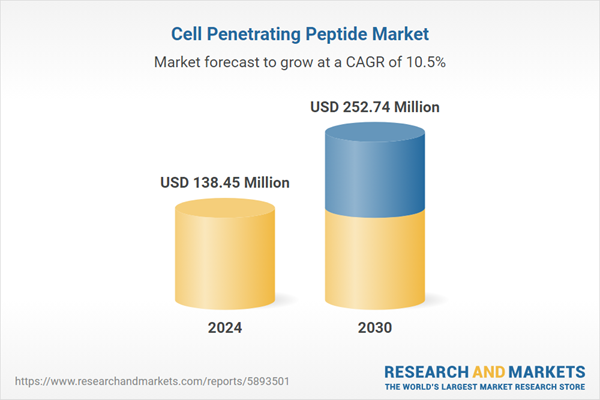Speak directly to the analyst to clarify any post sales queries you may have.
10% Free customizationThis report comes with 10% free customization, enabling you to add data that meets your specific business needs.
Key Market Drivers
Rising Demand for Targeted Drug Delivery
Targeted drug delivery is transforming modern therapeutics by enhancing treatment efficacy while minimizing side effects. This approach aligns well with the capabilities of cell-penetrating peptides (CPPs), which have emerged as crucial facilitators in the delivery of biologically active molecules across cellular membranes. According to a 2024 study published in Nature Reviews Drug Discovery, over 65% of current pipeline drugs under development aim to incorporate targeted delivery mechanisms. CPPs are increasingly being recognized for their potential to navigate biological barriers and deliver therapeutic agents precisely to disease-affected cells, making them indispensable tools in precision medicine.A major limitation of conventional drug delivery is nonspecific distribution, which often leads to systemic toxicity and diminished therapeutic outcomes. CPPs address this by enabling selective delivery of therapeutic molecules such as peptides, proteins, and nucleic acids directly to the desired cells or tissues. In fact, recent findings from the Journal of Controlled Release (2023) highlighted that CPPs improved cellular uptake efficiency by over 80% compared to traditional passive delivery systems in preclinical models. This enhanced specificity helps reduce the exposure of healthy tissues to potent therapeutics, thereby mitigating adverse effects and improving patient safety profiles.
Diseases like cancer, neurological disorders, and genetic conditions pose complex delivery challenges due to biological barriers such as the blood-brain barrier (BBB) and cellular membranes. CPPs possess the unique ability to cross these barriers and deliver drugs to previously inaccessible locations. For example, in neuro-oncology research, CPP-modified nanoparticles have demonstrated efficient transport across the BBB, offering promising solutions for treating glioblastoma and other brain cancers. This has accelerated the exploration of CPPs in clinical trials targeting central nervous system (CNS) disorders, where traditional therapies often fail due to poor bioavailability at the target site.
As the push for personalized medicine intensifies, the pharmaceutical and biotech sectors are investing in innovative drug delivery platforms. CPPs offer a flexible platform for delivering a broad spectrum of therapeutics across multiple disease categories. Their compatibility with gene therapy, mRNA delivery, and protein replacement therapies is particularly noteworthy. The growing use of AI-driven peptide design and advanced conjugation techniques is further optimizing CPP-based formulations for clinical use. With increasing validation in translational research, CPPs are poised to play a pivotal role in meeting the global demand for precise and personalized treatment modalities.
Key Market Challenges
Efficiency and Specificity of Delivery
The efficiency of CPP-mediated delivery can vary significantly across different cell types. Achieving consistent and reliable uptake of therapeutic cargoes across diverse cell lines is a complex task. Researchers must optimize CPP sequences and cargoes for each specific cell type of interest, which can be time-consuming and resource-intensive. The type of cargo being delivered plays a crucial role in the efficiency of CPP-mediated delivery. While CPPs are versatile carriers, some cargoes may interact poorly with certain CPPs or their mechanisms of uptake. Ensuring compatibility between CPPs and various therapeutic payloads is a challenge that requires careful consideration.Achieving specificity in delivery is essential to minimize off-target effects on healthy cells and tissues. CPPs must be engineered to ensure that they selectively target disease-associated cells while sparing non-targeted cells. Achieving this level of precision remains a significant challenge and a barrier to clinical adoption. While CPPs often exhibit promising results in vitro, translating their efficacy to in vivo settings can be challenging. Factors such as immune response, tissue distribution, and systemic clearance can affect the performance of CPPs in live organisms, necessitating further research and optimization. Some CPPs have been associated with cytotoxic effects at high concentrations or when used over extended periods.
Achieving the right balance between efficient delivery and low toxicity is crucial for the clinical viability of CPP-based therapies. The development of new drug delivery technologies, including CPPs, requires navigating complex regulatory pathways to ensure safety and efficacy. Demonstrating the efficiency and specificity of delivery, as well as addressing potential concerns, is essential for obtaining regulatory approvals. The commercial viability of CPP-based therapies depends on their ability to deliver therapeutic benefits that outweigh the challenges associated with efficiency and specificity. This requires substantial investment in research, development, and clinical validation.
Key Market Trends
Advancements in Peptide Engineering
Advancements in peptide engineering enable the creation of CPPs with specific cellular uptake mechanisms. Researchers can design CPPs that interact favorably with certain types of cells, optimizing cellular uptake efficiency and enhancing the overall efficacy of drug delivery. Through peptide engineering, CPPs can be optimized to deliver a wide range of therapeutic cargoes, including small molecules, peptides, proteins, and nucleic acids. Fine-tuning the interactions between CPPs and cargoes leads to improved delivery efficiency and specificity. Peptide engineering allows for the incorporation of targeting ligands that guide CPPs to specific receptors on target cells.This modification enhances the specificity of drug delivery, reducing off-target effects and minimizing potential side effects. By carefully designing and modifying CPP sequences, researchers can mitigate potential cytotoxic effects associated with some CPPs. This optimization is crucial for ensuring the safety of CPP-based therapies and widening their clinical application. Advances in peptide engineering enable the creation of multi-functional CPPs that can simultaneously deliver therapeutic agents and offer diagnostic capabilities. This innovation is particularly valuable in precision medicine approaches and combination therapies.
Key Market Players
- The Cupid Peptide Company
- AltaBioscience Ltd.
- AnaSpec Inc.
- Peptomyc SL
- Amidebio LLC
- Biopeptide Co LLC
- AAPPTec
- CSBio Company Inc
- CEM Corporation
- Bachem Holding AG
Report Scope:
In this report, the Global Cell Penetrating Peptide Market has been segmented into the following categories, in addition to the industry trends which have also been detailed below:Cell Penetrating Peptide Market, By Type:
- Protein-based CPPs
- Peptide-based CPPs
Cell Penetrating Peptide Market, By Application:
- Drug Delivery
- Gene Delivery
- Diagnostics
- Molecular Imaging
- Others
Cell Penetrating Peptide Market, By End User:
- Pharmaceutical and Biotechnology Companies
- Contract Research Organizations (CROs)
- Hospitals and Clinics
Cell Penetrating Peptide Market, By Region:
- North America
- United States
- Canada
- Mexico
- Europe
- France
- United Kingdom
- Italy
- Germany
- Spain
- Asia-Pacific
- China
- India
- Japan
- Australia
- South Korea
- South America
- Brazil
- Argentina
- Colombia
- Middle East & Africa
- South Africa
- Saudi Arabia
- UAE
Competitive Landscape
Company Profiles: Detailed analysis of the major companies present in the Global Cell Penetrating Peptide Market.Available Customizations:
With the given market data, the publisher offers customizations according to a company's specific needs. The following customization options are available for the report.Company Information
- Detailed analysis and profiling of additional market players (up to five).
This product will be delivered within 1-3 business days.
Table of Contents
Companies Mentioned
- The Cupid Peptide Company
- AltaBioscience Ltd.
- AnaSpec Inc
- Peptomyc SL
- Amidebio LLC
- Biopeptide Co LLC
- AAPPTec
- CSBio Company Inc
- CEM Corporation
- Bachem Holding AG
Table Information
| Report Attribute | Details |
|---|---|
| No. of Pages | 188 |
| Published | August 2025 |
| Forecast Period | 2024 - 2030 |
| Estimated Market Value ( USD | $ 138.45 Million |
| Forecasted Market Value ( USD | $ 252.74 Million |
| Compound Annual Growth Rate | 10.5% |
| Regions Covered | Global |
| No. of Companies Mentioned | 10 |









